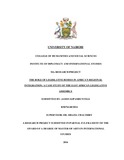| dc.description.abstract | East Africa Legislative Assembly is the legislative arm of the EAC. It’s mandated to
exercise legislative powers on behave of the community and therefore has a major role to
play in the achievement of the goal of integrating the East African region. Despite the
fact that regional integration brings about both the internal and external growth, it is also
faced with a lot of challenges that slow down its pace. Although some African leaders do
support the process of regional integration, it still lugs behind as compared to some
regional integrations around the world. Although this slow pace of the process can be
attributed to the fact that Africa is comprised mostly of least developed countries, there
are other challenges as well. Based on these issues, this research seeks to investigate the
role of legislative bodies in Africa’s regional integration. Key objectives of this study is
to determine the pace of regional integration in Africa; to examine the powers of the
legislative assembly over member states of the East African Community and evaluate the
extent at which these powers affect the conduct of member states in regard to their
commitments to regional integration. Key Questions therefore are; what is the pace of
regional integration in Africa? What are the powers of the legislative assembly over
member states of the East African Community? To what extent do these powers affect the
member states in regard to their commitments to regional integration? The Liberal Intergovernmentalism
theory is the main theory used in this study. Different studies been
conducted on the effectiveness of regional integration in relation to the accomplishment
of the set objectives mostly focusing on the effects of integration on economic growths.
In the case of East African Community, the East African Legislative Assembly was
established to oversee the formulation of laws that facilitate integration in the East
African Community. Nonetheless, there has been no study carried out to establish the role
played by the Assembly in achievement of regional integration objectives and hence this
study. The research employed the use of the descriptive research design. Descriptive
method is applied in the identification and achievement of information based on the
characteristics of certain issues and the data collected are quantitative in nature. In
addition, the statistical techniques are employed in the process of summarizing
information. The study established that several achievements have been realized in EAC.
Regional integration process is deepening particularly due to the expanding scope of the
legislative instruments, coordination of national economic and social policies, the
expansion of trade between EAC countries as well as its trade with the rest of the world.
The Assembly has and exercises powers over member states through legislation and
oversight of council of ministers. EALA have contributed but not fully achieved the
ultimate goal of full integration of the East Africa Community since out of the four pillars
of integration, only two have so far been achieved. It is apparent that much work
remains to be done to ensure that EALA has both the requisite legal and institutional
capacity to steer the process of integration of East Africa. | en_US |



